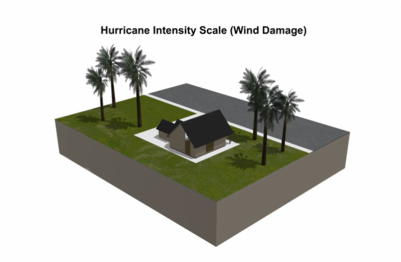Hurricane Information

What are Hurricanes?
Hurricanes are violent tropical storms with sustained winds of at least 74 mph. They form over warm ocean waters – usually starting as storms in the Caribbean or off the west coast of Africa. As they drift slowly westward, they are fueled by the warm waters of the tropics. Warm, moist air moves toward the center of the storm and spirals upward. This releases torrential rains. As updrafts suck up more water vapor, it triggers a cycle of strengthening that can be stopped only when contact is made with land or cooler water.
Hurricane Terms
- Tropical Depression - an organized system of clouds and thunderstorms with a defined circulation and maximum sustained winds of 38 mph (33 knots) or less.
- Tropical Storm - an organized system of strong thunderstorms with a defined circulation and maximum sustained winds of 39 to 73 mph (34-63 knots).
- Hurricane - a warm-core tropical cyclone with maximum sustained winds of 74 mph (64 knots) or greater.
- Eye - center a a hurricane with light winds and partly cloudy to clear skies. The eye is usually around 20 miles in diameter, but can range between 5 and 60 miles.
- Eye Wall - location within a hurricane where the most damaging winds and intense rainfall are found.
WEATHER TERMS
Hurricane WATCH:
- A hurricane WATCH means that hurricane conditions (sustained winds of 74 mph or higher) are possible within the specified area. A hurricane watch is issued 48 hours in advance of the anticipated onset of tropical-storm-force winds in an area.
- During a hurricane watch, prepare your home and review your plan for evacuation in case a hurricane or tropical storm warning is issued. Listen closely to instructions from local officials.
Hurricane WARNING:
- A hurricane WARNING indicates that hurricane conditions (sustained winds of 74 mph or higher) are expected somewhere within the specified area. Because hurricane preparedness activities become difficult once winds reach tropical storm force (sustained winds of 39 to 73 mph), the hurricane warning is issued 36 hours in advance of the anticipated onset of tropical-storm-force winds to allow for important preparation.
- During a hurricane warning, complete storm preparations and immediately leave the threatened area if directed by state and local officials.
Saffir-Simpson Scale:
The Saffir-Simpson Scale classifies hurricanes by maximum sustained winds. This scale does not take into account other potentially deadly hazards such as storm surge, rainfall flooding, and tornadoes.
- Category 1: 74 to 95 MPH sustained wind speed
- Category 2: 96 to 110 MPH sustained wind speed
- Category 3: 111 to 129 MPH sustained wind speed
- Category 4: 130 to 156 MPH sustained wind speed
- Category 5: Over 157 MPH sustained wind speed
Major hurricanes can cause devastating to catastrophic wind damage and significant loss of life simply due to the strength of their winds. Hurricanes of all categories can produce deadly storm surge, rain-induced floods, and tornadoes. These hazards require people to take protective action, including evacuating from areas vulnerable to storm surge.
Watch the Hurricane Intensity Scale video
Learn more: NOAA Glossary of National Hurricane Center Terms



